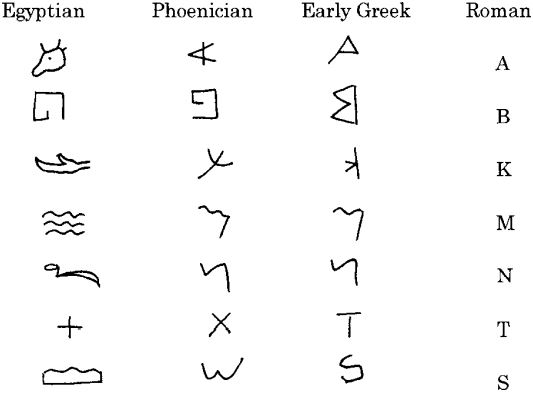


 Grammar
Grammar
 Tenses
Tenses
 Present
Present
 Past
Past
 Future
Future
 Parts Of Speech
Parts Of Speech
 Nouns
Nouns
 Verbs
Verbs
 Adverbs
Adverbs
 Adjectives
Adjectives
 Pronouns
Pronouns
 Pre Position
Pre Position
 Preposition by function
Preposition by function 
 Preposition by construction
Preposition by construction
 Conjunctions
Conjunctions
 Interjections
Interjections
 Grammar Rules
Grammar Rules
 Linguistics
Linguistics
 Semantics
Semantics
 Pragmatics
Pragmatics
 Reading Comprehension
Reading Comprehension|
Read More
Date: 2024-09-23
Date: 2024-09-17
Date: 2024-09-13
|
Alphabetic writing
If you have a set of symbols being used to represent syllables beginning with, for example, a b sound or an m sound, then you are actually very close to a situation in which the symbols can be used to represent single sound types in a language. This is, in effect, the basis of alphabetic writing. In principle, an alphabet is a set of written symbols, each one representing a single type of sound or phoneme. The situation just described is what seems to have occurred in the development of the writing systems of Semitic languages such as Arabic and Hebrew. Words written in these languages, in everyday use, largely consist of symbols for the consonant sounds in the word, with the appropriate vowel sounds being supplied by the reader (or rdr).
This type of writing system is sometimes called a consonantal alphabet. The early version of Semitic alphabetic script, originating in the writing system of the Phoenicians, is the basic source of most other alphabets to be found in the world. Modified versions can be traced to the East into Iranian, Indian and South-East Asian writing systems and to the West through Greek. The basic order of letter symbols, with “A” representing a consonant in the first “ABCD…,” was created about three thousand 216 The Study of Language years ago by the Phoenicians and continues to be used as our primary ordering device for lists in everything from dictionaries to telephone books.
The early Greeks took the alphabetizing process a stage further by also using separate symbols to represent the vowel sounds as distinct entities, and so created a remodeled system that included vowels. This change resulted in the Phoenician consonant “alep” becoming a symbol for a vowel sound as A (called “alpha”) to go with existing symbols for consonant sounds such as B (called “beta”), giving us singlesound writing or an “alphabet.” In fact, for some writers on the origins of the modern alphabet, it is the Greeks who should be given credit for taking the inherently syllabic system from the Phoenicians and creating a writing system in which the single-symbol to single-sound correspondence was fully realized.
From the Greeks, this revised alphabet passed to the rest of Western Europe through the Romans and, along the way, underwent several modifications to fit the requirements of the spoken languages encountered. As a result, we talk about the Roman alphabet as the writing system used for English. Another line of development took the same basic Greek writing system into Eastern Europe where Slavic languages were spoken. The modified version, called the Cyrillic alphabet (after St. Cyril, a ninthcentury Christian missionary), is the basis of the writing system used in Russia today.
The actual form of a number of letters in modern European alphabets can be traced from their origins in Egyptian hieroglyphics. The examples in the accompanying illustration are based on Davies (1987).

|
|
|
|
تفوقت في الاختبار على الجميع.. فاكهة "خارقة" في عالم التغذية
|
|
|
|
|
|
|
أمين عام أوبك: النفط الخام والغاز الطبيعي "هبة من الله"
|
|
|
|
|
|
|
قسم شؤون المعارف ينظم دورة عن آليات عمل الفهارس الفنية للموسوعات والكتب لملاكاته
|
|
|